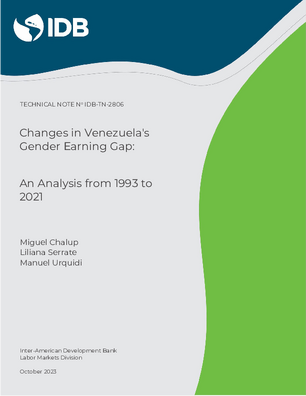Changes in Venezuela's Gender Earning Gap: An Analysis from 1993 to 2021
Date
Oct 2023
The gender earnings gap in Latin America poses a barrier to achieving gender equality and sustainable development. In Venezuela, this gap persists despite women often having a better labor profile than men, suggesting the possible existence of gender biases. Heterogeneous income differences in favor of men were found in most occupations, although a slight shift toward equity is observed in the persistent earnings gap among informal sector workers. To analyze the gender earnings gap in Venezuela between 1993 and 2021, this study uses the Harmonized Household Surveys (HHS) and the National Survey of Living Conditions (ENCOVI) harmonized by the Inter-American Development Bank (IDB). Two methodologies are presented for estimating the gap: the Blinder-Oaxaca decomposition and the Ñopo method. The analysis over more than two decades suggests the existence of gender biases as one of the unexplained factors of the gap. The analysis also shows a gradual reduction in the total gender earnings gap between men and women in the 1990s, followed by an increasing trend from the beginning of the 21st century. This indicates that additional efforts are needed to understand the observed disparity. While the analysis shows variations in the total gap, these are generally related to the explained gap (derived from individual endowments in education, work experience, age) rather than a reduction of the gap that cannot be explained by these variables. Such unexplained gap might be associated with gender differentiated regulations, biases, prejudices, discrimination, or other factors that need to be identified to establish policies for its reduction.




